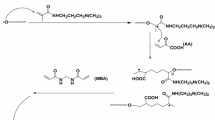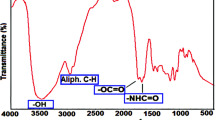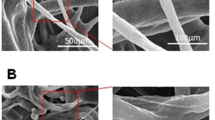Abstract
In this article, a novel triple-stimuli hydrogel was prepared by simultaneous formation of super paramagnetic iron oxide nanoparticles (SPION) and crosslinking of poly (acrylic acid) grafted onto kappa carrageenan (κC-g-PAA). The structure, thermal stability, surface morphology, and magnetic property of the κC-g-PAA/SPION hydrogel were characterized by Fourier transform infrared spectroscopy (FT-IR), scanning electron microscopy with energy dispersive X-ray analysis (SEM–EDAX), transmission electron microscopy (TEM), thermal gravimetric analysis (TGA), and vibrating sample magnetometer (VSM). Moreover, swelling capacity of the obtained hydrogel was measured at different temperature, pH, and magnetic-field to assess the sensitivity of κC-g-PAA/SPION hydrogel. This synthetic hydrogel was also examined as a controlled drug delivery system and defrasirox release was investigated at different temperature, pH, and magnetic-field. The in vitro antibacterial activity of κC-g-PAA/SPION hydrogel was studied against Escherichia coli and Staphylococcus aureus bacteria where the results showed no antibacterial activity of this new hydrogel. In vitro biocompatibility experiments were undertaken using human bladder epithelial cell line HTB 5637. These results indicated the synthesized κC-g-PAA/SPION hydrogel are nontoxic that will be useful for biomedical applications.

We introduce a novel triple-stimuli and biocompatible kappa-carrageenan-g-poly(acrylic acid)/SPION nanocomposite as a drug delivery system



















Similar content being viewed by others
References
Wang C, Huang H, Hsu C, Shyu Y, Yang BB (2013) Inactivation and morphological damage of Vibrio parahaemolyticus treated with high hydrostatic pressure. Food Control 32:348–353
Yu S, Hsieh H, Pang J, Tang D, Shih C, Tsai M, Tsai Y, Mi F (2013) Active films from water-soluble chitosan/cellulose composites incorporating releasable caffeic acid for inhibition of lipid oxidation in fish oil emulsions. Food Hydrocolloids 32:9–19
Zheng K, Zou A, Yang X, Liu F, Xia Q, Ye R, Mu B (2013) The effect of polymer–surfactant emulsifying agent on the formation and stability of α-lipoic acid loaded nanostructured lipid carriers (NLC). Food Hydrocolloids 32:72–78
Zhang S, Coultas KA (2013) Identification of plumbagin and sanguinarine as effective chemotherapeutic agents for treatment of schistosomiasis. Int J Parasitol Drugs Drug Resist 3:28–34
Dunjic-Kostic B, Ivkovic M, Radonjic NV, Petronijevic ND, Pantovic M (2013) Melancholic and atypical major depression — Connection between cytokines, psychopathology and treatment. Prog Neuro-Psychopharmacol Biol Psychiatry 43:1–6
Raza K, Singh B, Singal P, Wadhwa S, Katare OP (2013) Systematically optimized biocompatible isotretinoin-loaded solid lipid nanoparticles (SLNs) for topical treatment of acne. Colloids Surf B 105:67–74
Aguzzi C, Viseras C, Cerezo P, Salcedo I, Sánchez-Espejo R, Valenzuela C (2013) Release kinetics of 5-aminosalicylic acid from halloysite. Colloids Surf B 105:75–80
Zeng J, Huang H, Liu S, Xu H, Huang J, Yu J (2013) Hollow nanosphere fabricated from β-cyclodextrin-grafted α, β-poly(aspartic acid) as the carrier of camptothecin. Colloids Surf B 105:120–127
Luo Y, Teng Z, Wang X, Wang Q, Development of carboxymethyl chitosan hydrogel beads in alcohol-aqueous binary solvent for nutrient delivery applications. Food Hydrocolloids 31:332–339
Li K, Yu L, Liu X, Chen C, Chen Q, Ding J (2013) A long-acting formulation of a polypeptide drug exenatide in treatment of diabetes using an injectable block copolymer hydrogel. Biomaterials 34:2834–2842
Jung J, Arnold RD, Wicker L (2013) Pectin and charge modified pectin hydrogel beads as a colon-targeted drug delivery carrier. Colloids Surf B 104:116–121
Wang Y, Zhang Z, Xu L, Li X, Chen H (2013) Hydrogels of halogenated Fmoc-short peptides for potential application in tissue engineering. Colloids Surf B 104:163–168
Bardajee GR, Hooshyar Z, Rezanezhad H (2012) A novel and green biomaterial based silver nanocomposite hydrogel: Synthesis, characterization and antibacterial effect. J Inorg Biochem 117:367–373
Bardajee GR, Pourjavadi A, Soleyman R (2011) Novel nano-porous hydrogel as a carrier matrix for oral delivery of tetracycline hydrochloride. Colloids Surf A 392:16–24
Bardajee GR, Pourjavadi A, Ghavami S, Soleyman R, Jafarpour F (2011) UV-prepared salep-based nanoporous hydrogel for controlled release of tetracycline hydrochloride in colon. J Photochem Photobiol 102:232–240
Luo Y, Teng Z, Wang X, Wang Q (2013) Development of carboxymethyl chitosan hydrogel beads in alcohol-aqueous binary solvent for nutrient delivery applications. Food Hydrocolloids 31:332–339
Conti B, Colzani B, Papetti A, Mascherpa D, Dorati R, Genta I, Pruzzo C, Signoretto C, Zaura E, Lingström P, Ofek I, Wilson M, Spratt DA, Gazzani G (2013) Adhesive microbeads for the targeting delivery of anticaries agents of vegetable origin. Food Chem 138:898–904
Gurunathan S, Han JW, Eppakayala V, Kim J (2013) Biocompatibility of microbially reduced graphene oxide in primary mouse embryonic fibroblast cells. Colloids Surf B 105:58–66
Jana S, Saha A, Nayak AK, Sen KK, Basu SK (2013) Aceclofenac-loaded chitosan-tamarind seed polysaccharide interpenetrating polymeric network microparticles. Colloids Surf B 105:303–309
Roux R, Ladavière C, Montembault A, Delair T (2013) Particle assemblies: Toward new tools for regenerative medicine. Mater Sci Eng C 33:997–1007
Yeh J, Yang H, Hsu Y, Su C, Lee T, Lou S (2013) Synthesis and characteristics of biodegradable and temperature responsive polymeric micelles based on poly(aspartic acid)-g-poly(N-isopropylacrylamide-co-N, N-dimethylacrylamide). Colloids Surf A 421:1–8
Haldar S, Maji SK (2013) Role of non-covalent interactions in the molecular organization of N-n-hexadecanoyl amino acid amphiphiles with hydrophobic Cα-side chains in Tris buffer (pH 9.3). Colloids Surf A 420:10–21
Dadsetan M, Taylor KE, Yong C, Bajzer Z, Lu L, Yaszemski MJ (2013) Controlled release of doxorubicin from pH-responsive microgels. Acta Biomater 9:5438–5446
Rodrigues LAS, Figueiras A, Veiga F, Freitas RM, Nunes LCC, Filho ECS, Leite CMS (2013) The systems containing clays and clay minerals from modified drug release: A review. Colloids Surf B 103:642–651
Zhou Y, Fan X, Xue D, Xing J, Kong J (2013) Thermosensitive supramolecular hydrogels from atom transfer radical polymerization of polypseudorotaxanes self-assembled by triblock copolymer and α-cyclodextrins. React Funct Polym 73:508–517
Cheng Y, Yang S, Liu C, Gefen A, Lin F (2013) Thermosensitive hydrogel made of ferulic acid-gelatin and chitosan glycerophosphate. Carbohydr Polym 92:1512–1519
Sun X, Wang H, Jing Z, Mohanathas R (2013) Hemicellulose-based pH-sensitive and biodegradable hydrogel for controlled drug delivery. Carbohydr Polym 92:1357–1366
Li WM, Chen SY, Liu DM (2013) In situ doxorubicin–CaP shell formation on amphiphilic gelatin–iron oxide core as a multifunctional drug delivery system with improved cytocompatibility, pH-responsive drug release and MR imaging. Acta Biomater 9:5360–5368
Fana T, Li M, Wub X, Li M, Wu Y (2011) Preparation of thermoresponsive and pH-sensitivity polymer magnetic hydrogel, nanospheres as anticancer drug carriers. Colloids Surf B 88:593–600
Yang L, Guo C, Jia L, Xie K, Shou Q, Liu H (2010) Fabrication of Biocompatible Temperature- and pH-Responsive Magnetic Nanoparticles and Their Reversible Agglomeration in Aqueous Milieu. Ind Eng Chem Res 49:8518–8525
Wang Y, Dong A, Yuan Z, Chen D (2012) Fabrication and characterization of temperature-, pH- and magnetic-field-sensitive organic/inorganic hybrid poly (ethylene glycol)-based hydrogels. Colloids Surf A 415:68–76
Peppas NA, Merrill EW (1976) Poly(vinyl alcohol) hydrogels: Reinforcement of radiation-crosslinked networks by crystallization. J Polym Sci Polym Chem Educ 14:441–457
Bardajee GR, Pourjavadi A, Soleyman R, Sheikh N (2008) Irradiation mediated synthesis of a superabsorbent hydrogel network based on polyacrylamide grafted onto salep. Nucl Instrum Meth Phys Res Sect B 266:3932–3938
Bardajee GR, Pourjavadi A, Soleyman R, Sheikh N (2010) Gamma irradiation mediated synthesis of a new superabsorbent hydrogel network based on poly(acrylic acid) grafted onto salep. J Iran Chem Soc 7:652–662
Güven O, Şen M, Karadağ E, Saraydın D (1999) A review on the radiation synthesis of copolymeric hydrogels for adsorption and separation purposes. Radiat Phys Chem 56:381–386
Zhou L, He B, Zhang F (2012) Facile One-Pot Synthesis of Iron Oxide Nanoparticles Cross-linked, Magnetic Poly(vinyl alcohol) Gel Beads for Drug Delivery. ACS Appl Mater Interfaces 4:192–199
Mihaila SM, Gaharwar AK, Reis RL, Marques AP, Gomes ME, Khademhosseini A (2012) Photocrosslinkable Kappa-Carrageenan Hydrogels for Tissue Engineering Applications. Adv Healthc Mater. doi:10.1002/adhm.201200317
Chen J, Liu M, Chen S (2009) Synthesis and characterization of thermo- and pH-sensitive kappa-carrageenan-g-poly(methacrylic acid)/poly(N, N-diethylacrylamide) semi-IPN hydrogel. Mater Chem Phys 115:339–346
Jing R, Yanqun Z, Jiuqiang L, Hongfei H (2001) Radiation synthesis and characteristic of IPN hydrogels composed of poly(diallyldimethylammonium chloride) and Kappa-Carrageenan. Radiat Phys Chem 62:277–281
Salvemini D, Wang Z, Wyatt PS, Bourdon DM, Marino MH, Manning PT, Currie MG (1996) Nitric oxide: a key mediator in the early and late phase of carrageenan-induced rat paw inflammation. Br J Pharmacol 118:829–838
Pourjavadi A, Harzandi AM, Hosseinzadeh H (2004) Synthesis of a novel polysaccharide-based superabsorbent hydrogel via graft copolymerization of acrylic acid onto kappa-carrageenan in air. Eur Polym J 40:1363–1370
Francis S, Kumar M, Varshney L (2004) Radiation synthesis of superabsorbent poly(acrylic acid)–carrageenan hydrogels. Radiat Phys Chem 69:481–486
Bardajee GR, Pourjavadi A, Sheikh N, Amini-Fazl MS (2008) Grafting of acrylamide onto kappa-carrageenan via γ-irradiation: Optimization and swelling behavior. Radiat Phys Chem 77:131–137
Abd El-Mohdy HL, Abd El-Rehim HA (2009) Radiation synthesis of kappa-carrageenan/acrylamide graft copolymers as superabsorbents and their possible applications. J Polym Res 16:63–72
Pourjavadi A, Ghasemzadeh H (2007) Carrageenan-g-poly(acrylamide)/poly(vinylsulfonic acid, sodium salt) as a novel semi-IPN hydrogel: Synthesis, characterization, and swelling behavior. Polym Eng Sci 47:1388–1395
Hosseinzadeh H, Pourjavavdi A, Zohuriaan-Mehr MJ (2004) Modified carrageenan. 2. Hydrolyzed crosslinked κ-carrageenan-g-PAAm as a novel smart superabsorbent hydrogel with low salt sensitivity. J Biomater Sci Polym Ed 15:1499–1511
Wan S, Huang J, Yan H, Liu K (2006) Size-controlled preparation of magnetite nanoparticles in the presence of graft copolymers. J Mater Chem 16:298–303
Bardajee GR, Hooshyar Z (2013) Novel potentially biocompatible nanoporous hydrogel based on poly ((2-dimethylaminoethyl) methacrylate) grafted onto salep: synthesis, swelling behavior and drug release study. J Polym Res 2013(20):67–74
Liu T, Hu S, Liu T, Liu D, Chen S (2006) Magnetic-Sensitive Behavior of Intelligent Ferrogels for Controlled, Release of Drug. Langmuir 22:5974–5978
Philippova O, Barabanova A, Molchanov V, Khokhlov A (2011) Magnetic polymer beads: Recent trends and developments in synthetic, design and applications. Eur Polym J 47:542–559
Sivalingam G, Karthik R, Madras G (2003) Effect of Metal Oxides on Thermal Degradation of Poly(vinyl acetate) and Poly(vinyl chloride) and Their Blends. Ind Eng Chem Res 2003(42):3647–3653
Gorghiu LM, Jipa S, Zaharescu T, Setnescu R, Mihalcea I (2004) The effect of metals on thermal degradation of polyethylenes. Polym Degrad Stab 84:7–11
Serra L, Doménech J, Peppas NA (2006) Drug transport mechanisms and release kinetics from molecularly designed poly(acrylic acid-g-ethylene glycol) hydrogels. Biomaterials 27:5440–5451
Ying E, Hwang H (2010) In vitro evaluation of the cytotoxicity of iron oxide nanoparticles with different coatings and different sizes in A3 human T lymphocytes. Sci Total Environ 408:4475–4481
Mahmoudi M, Simchi A, Milani AS, Stroeve P (2009) An in vitro study of bare and poly(ethylene glycol)-co-fumarate-coated superparamagnetic iron oxide nanoparticles: a new toxicity identification procedure. J Colloid Interface Sci 336:510–518
Acknowledgements
We are grateful to the PNU and INSF for funding this work.
Author information
Authors and Affiliations
Corresponding author
Rights and permissions
About this article
Cite this article
Bardajee, G.R., Hooshyar, Z. & Rastgo, F. Kappa carrageenan-g-poly (acrylic acid)/SPION nanocomposite as a novel stimuli-sensitive drug delivery system. Colloid Polym Sci 291, 2791–2803 (2013). https://doi.org/10.1007/s00396-013-3018-6
Received:
Revised:
Accepted:
Published:
Issue Date:
DOI: https://doi.org/10.1007/s00396-013-3018-6




